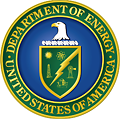FUTURE 1.0 Thrusts
CONTACT US
- Director
- Blas Uberuaga
- LANL
- (505) 667-9105
- Deputy Director
- Peter Hosemann
- UC Berkeley
- (510) 717-5752
Thrust 1: Point Defects |
|
Context: During irradiation, energetic particles smashing into materials create a high concentration of non-equilibrium point defects, defects that wouldn't be there if there was no irradiation. These defects are all-important for driving the motion of atoms through the material, leading to changes in the chemical make-up and distribution of the material and the rates and mechanisms of corrosion. It is thus imperative to understand the nature of these defects. Motivating Scientific Question: How do coupled extremes affect defect populations and kinetics? Approach: FUTURE will use in situ transmission electron microscopy to look at materials as they are irradiated in the microscope. While this technique is blind to the very smallest defects, it can reveal the nature of larger defects -- dislocation loops and cavities -- that provide invaluable insight into how those smallest defects evolve. To address the smallest defects, FUTURE will pioneer the use of in situ positron annihilation spectroscopy to directly quantify the populations of point defects in the material as it is being irradiated, revealing the nature of those defects. This will not only provide unprecedented insight into what defects are produced during irradiation, but also serve as critical benchmark for the validation of computational models. Thrust Lead: Farida Selim of Bowling Green State University. |
Thrust 2: Coupled Transport |
|
Context: The defects produced via irradiation move through the material and, as a consequence, move the atoms in the material. Further, these defects and atoms interact with the microstructure -- grain boundaries and dislocations. This can cause significant changes in the elemental composition of the material that will impact how the material interacts with a corrosive environment. To understand how corrosion is impact by irradiation, we must first understand how the chemical make-up of the material changes with irradiation. Motivating Scientific Question: How is species transport impacted by non-equilibrium defect populations? Approach: FUTURE will utilize the cutting edge in strain mapping and four-dimensional scanning transmission electron microscopy to examine materials exposed to a combination of corrosive and irradiation environments. FUTURE will advance the use of isotopes to understand detailed transport mechanisms in materials. Coupled with atom probe tomography, the use of isotopes will allow us to examine how transport differs in different parts of the material, for example at grain boundaries. By examining corrosive behavior before and after irradiation, we will elucidate the means by which irradiation impacts corrosion. Thrust Leads: Daniel Schreiber and Sandra Taylor of Pacific Northwest National Laboratory |
Thrust 3: Interfacial Transport/Reaction |
|
Context: Corrosion is inherently a surface phenomenon, in which a corrosive medium (in the case of FUTURE, liquid environments) comes in contact with a material. Think rust. The rates of corrosion are thus significantly impacted by surface processes, which in turn are governed by defects. Irradiation naturally and dramatically changes the defect content of a material. To understand how corrosion couples with irradiation, we must also understand how irradiation changes the reactions occurring at interfaces. Motivating Scientific Question: How do coupled extremes affect transport and reactions at solid/liquid interfaces? Approach: FUTURE will expand on the Irradiation and Corrosion Experiment -- also known as ICE -- which is a unique facility combining a corrosion cell with ion beam irradiation. Past work has shown that irradiation can change the thickness of the corroded layer by a factor of ten or more. FUTURE will add new capabilities to this experiment to probe how different corrosive environments -- liquid metals versus molten salts -- impact material evolution in an irradiation environment. These coupled effects studies will be complemented by detailed electrochemical impedance spectroscopy which targets the rates of reactions occurring at these interfaces that dictate the overall corrosive behavior. Thrust Lead: Peter Hosemann of the University of California, Berkeley |
Cross-cut Thrust: Multiscale Modeling |
|
Context: Ultimately, scientific understanding is demonstrated by the ability to explain experimental results and predict new outcomes. To understand the coupled extremes that drive transport in reactors, a multiscale model is a must, a model which accounts for the complex and evolving microstructure within the material during irradiation and how that microstructure and defect content couples with atomic transport. Motivating Scientific Theme: Develop a predictive model that links the experimental activities to bring true insight into fundamental mechanisms. Approach: FUTURE will both determine fundamental defect properties, via atomistic modeling, and develop mesoscale models built incorporating those properties to make predictions of coupled irradiation and corrosion in materials. This chemico-mechanical model, built on the foundations of cluster dynamics and dislocation dynamics, will account for local and evolving stresses in the material as a consequence of irradiation. Initially, boundary conditions describing the complex interfacial reactions will be described by the point defect model. These will be supplanted by more physics-based descriptions of the reactions as the project evolves. The models will both help interpret experiments, which serve as critical validation, and guide new experimental studies that lead to new understanding. Thrust Leads: Laurent Capolungo of Los Alamos National Laboratory and Mark Asta of the University of California, Berkeley. |




